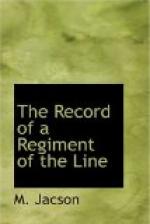A large donga was utilized by the Boers as a dressing station. The violent storm on the afternoon of the 6th filled all the dry dongas and turned them at once into mountain torrents. It is said that all the wounded Boers in this donga were swept out into the Klip River and drowned. The dead of the Regiment were buried with those of other regiments, in a grave under Wagon Hill. Captain Lafone and Lieutenant Field were buried in the cemetery in Ladysmith.
On the morning of January 8th all the wounded were sent by train to Intombi Camp, including Lieutenant Masterson, who was doing well.
On January 9th the Regiment was concentrated at the railway cutting, the company at the railway station having been permanently relieved from the post by a company of the Liverpool Regiment. The battalion was thus ready to be moved to any portion of the defences requiring assistance, in case of attack.
The estimation in which the battalion was held at this time by the Ladysmith garrison was well borne out by a remark made by Sir George White. “The Devons,” he said, “have never failed me yet. On the 6th they held one place and took another.”
A scare in the evening that the Boers were to attack again in the morning caused various preparations to be made for their advent. The garrison stood to arms at 3.15 a.m. awaiting the attack.
It is a curious fact that the Regiment was never ordered to stand to arms in the morning before three o’clock at any time previous to or after the 6th January, and the only time the Boers made a night attack they did so at 2.15 a.m. This was on January 6th, on which day the Regiment was ordered to stand to arms at 4.15 a.m.
During the night of January 9th-10th the naval guns fired in the direction of Surprise Hill, and whilst this was proceeding the mountain battery’s two remaining guns also threw some star shell in the same direction. The Boers were hugely elated at the sight of the star shell. This was probably the first time they had seen them. They turned their searchlight on to the stars when they fell on the ground, and cheered lustily. They evidently considered that it was a performance got up for their special entertainment by Messrs. Brock and Co., direct from the Crystal Palace.
The cause of all this shell fire was not known, but it would appear as if information had been received that the Boers had been collecting at the back of Surprise Hill the evening before, with a view to a renewed attack. Nothing, however, in the shape of an attack occurred, and at 3 a.m. firing ceased, and the sun rose in the morning in tranquillity.
On the 11th three messages were received by the garrison congratulating them on their good work of January 6th: one from the Governor of Natal, one from Valparaiso, and one from General Buller. The last named stated in his telegram that he would relieve Ladysmith as soon as possible.
It was stated that Sir George White had heliographed to Sir Redvers Buller informing him that there were over 2000 sick and wounded in Intombi Hospital Camp, that he could not hold out for much longer, and that he must not expect any assistance from him when he made his effort. Sir Redvers Buller had replied that he was sparing no effort to push forward, and that he hoped to be ready soon.




